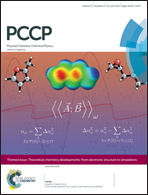Early regimes of water capillary flow in slit silica nanochannels
Abstract
Molecular dynamics simulations are conducted to investigate the initial stages of spontaneous imbibition of water in slit silica nanochannels surrounded by air. An analysis is performed for the effects of nanoscopic confinement, initial conditions of liquid uptake and air pressurization on the dynamics of capillary filling. The results indicate that the nanoscale imbibition process is divided into three main flow regimes: an initial regime where the capillary force is balanced only by the inertial drag and characterized by a constant velocity and a plug flow profile. In this regime, the meniscus formation process plays a central role in the imbibition rate. Thereafter, a transitional regime takes place, in which, the force balance has significant contributions from both inertia and viscous friction. Subsequently, a regime wherein viscous forces dominate the capillary force balance is attained. Flow velocity profiles identify the passage from an inviscid flow to a developing Poiseuille flow. Gas density profiles ahead of the capillary front indicate a transient accumulation of air on the advancing meniscus. Furthermore, slower capillary filling rates computed for higher air pressures reveal a significant retarding effect of the gas displaced by the advancing meniscus.


 Please wait while we load your content...
Please wait while we load your content...